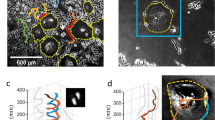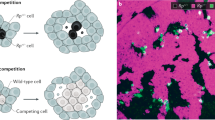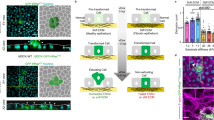Abstract
QUIESCENT, non-growing cultures of normal fibroblasts may arise as a result of absence of anchorage1,2 or deprivation either of serum macromolecules3–5 or of a variety of nutrients6. This state can also be induced by sulphated polysaccharides7,8 and we have reported the inhibition of growth of normal BHK/21 hamster fibroblasts in monolayer by dextran sulphate and heparin9 and the protection against this inhibition by purines10. Goto et al. have also found that dextran sulphate added to growing cultures markedly reduces the saturation density of established lines not transformed by viruses, but not that of primary embryonic fibroblasts11. The ability of many cells to grow in agar only after transformation with tumour viruses has been similarly ascribed to the inhibitory effects of sulphated polysaccharides8,12 and a close quantitative relationship has been reported between tumorigenicity and plating efficiency in agar13.
This is a preview of subscription content, access via your institution
Access options
Subscribe to this journal
Receive 51 print issues and online access
$199.00 per year
only $3.90 per issue
Buy this article
- Purchase on Springer Link
- Instant access to full article PDF
Prices may be subject to local taxes which are calculated during checkout
Similar content being viewed by others
References
Montagnier, L., Path. Biol., Paris, 14, 244–251 (1966).
Stoker, M., O'Neill, C., Berryman, S., and Waxman, V., Int. J. Cancer, 3, 683–693 (1968).
Todaro, G. J., Lazar, G. K., and Green, H., J. cell. comp. Physiol., 66, 325–333 (1965).
Temin, H., Int. J. Cancer, 3, 771–787 (1968).
Bürk, R. R., in Growth regulating substances for Animal Cells (edit. by Defendi, V., and Stoker, M.), 39–50 (Wistar Institute Press, Philadelphia, 1967).
Pardee, A. B., Proc. natn. Acad. Sci. U.S.A., 71, 1286–1290 (1974).
Temin, H., J. natn. Cancer Inst., 37, 168–175 (1966).
Montagnier, L., C.r. hebd. Séanc Acad. Sci. Paris, Serie D., 267, 921–924 (1968).
Clarke, G. D., and Stoker, M. G. P., Ciba Foundation Symposium, Growth control in Cell Cultures (edit. by Wolstenholme, G. E. W., and Knight, J.), 17–32 (Churchill, London, 1971).
Clarke, G. D., and Smith, D., J. cell. Physiol., 81, 125–131 (1973).
Goto, M., Kataoka, Y., Kimura, T., Goto, K., and Sato, H., Expl Cell Res., 82, 367–374 (1973).
Montagnier, L., C. r. hebd. Séanc Acad. Sci. Paris, Serie D., 268, 2218–2221 (1969).
Kakunga, T., and Kamahora, J., Biken J., 11, 313–332 (1968).
Bremerskov, V., Nature new Biol., 246, 174 (1973).
Elbein, A. D., Adv. Enzymol., 40, 29–64 (1974).
Birch, J. R., and Pirt, S. J., J. Cell Sci., 7, 661–670 (1970).
Bush, H., Proc. R. Soc. Med., 66, 1242–1243 (1973).
Author information
Authors and Affiliations
Rights and permissions
About this article
Cite this article
CLARKE, G., SHEARER, M. & RYAN, P. Association of polyanion resistance with tumorigenicity and other properties in BHK/21 cells. Nature 252, 501–503 (1974). https://doi.org/10.1038/252501a0
Received:
Revised:
Issue Date:
DOI: https://doi.org/10.1038/252501a0
This article is cited by
-
Cell surface and cell division
Cell Biophysics (1982)
-
A new fluorescence technique for staining of mononuclear phagocytes
Blut (1979)
Comments
By submitting a comment you agree to abide by our Terms and Community Guidelines. If you find something abusive or that does not comply with our terms or guidelines please flag it as inappropriate.



